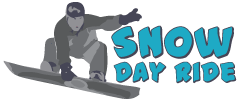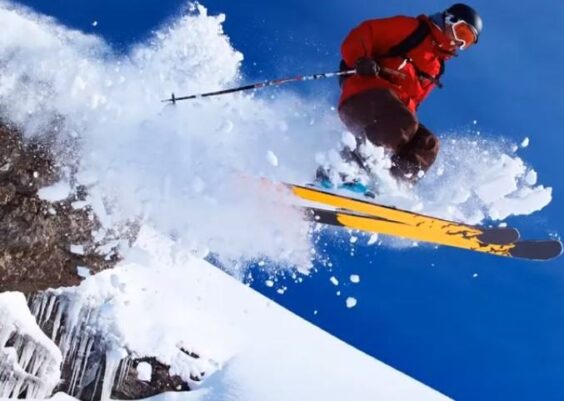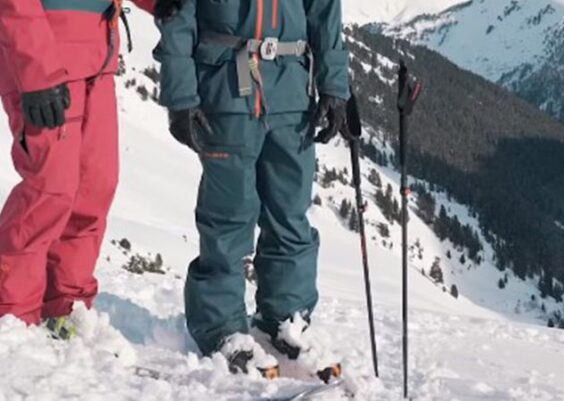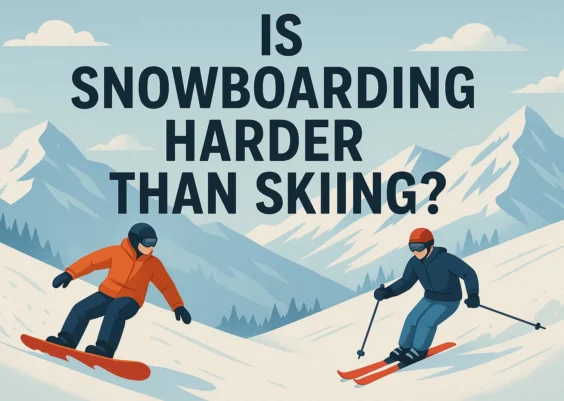Last updated on September 5th, 2025 at 02:01 pm
Key Takeaways
- Snowboard size depends mainly on height, weight, boot size, and riding style.
- Start with the 90% of height rule as a baseline, then adjust for weight and style.
- Men’s snowboards are typically longer, wider, and stiffer to match larger body types and bigger boots.
- Riding style makes a big differenc
- Flex ratings and volume shift boards also influence sizing decisions.
- Choosing the right size improves control, stability, carving ability, and overall fun.
The perfect snowboard sizes for men depends on height, weight, boot size, and riding style. Men usually ride longer and wider boards since they are taller, heavier, and wear bigger boots than women. Women’s boards, by contrast, are often shorter, narrower, and softer to match lighter frames and smaller boot sizes.
Picking the wrong size affects performance: a board too large feels stiff and hard to maneuver, while a board too small loses grip and stability. The right fit improves balance, carving, and comfort.
This guide explains the key sizing rules for men, highlights how boards differ between men and women, and shows how to match a board to your style and body.
What Are the Perfect Snowboard Sizes for Men?
For men, the quickest way to find the right snowboard size is to start with height. A simple rule is to choose a board that measures about 90 percent of your height.
For example, if you are 5’9” (175 cm), a board around 157 cm is a reliable starting point. From there, you fine-tune the size by looking at your weight and how you ride.
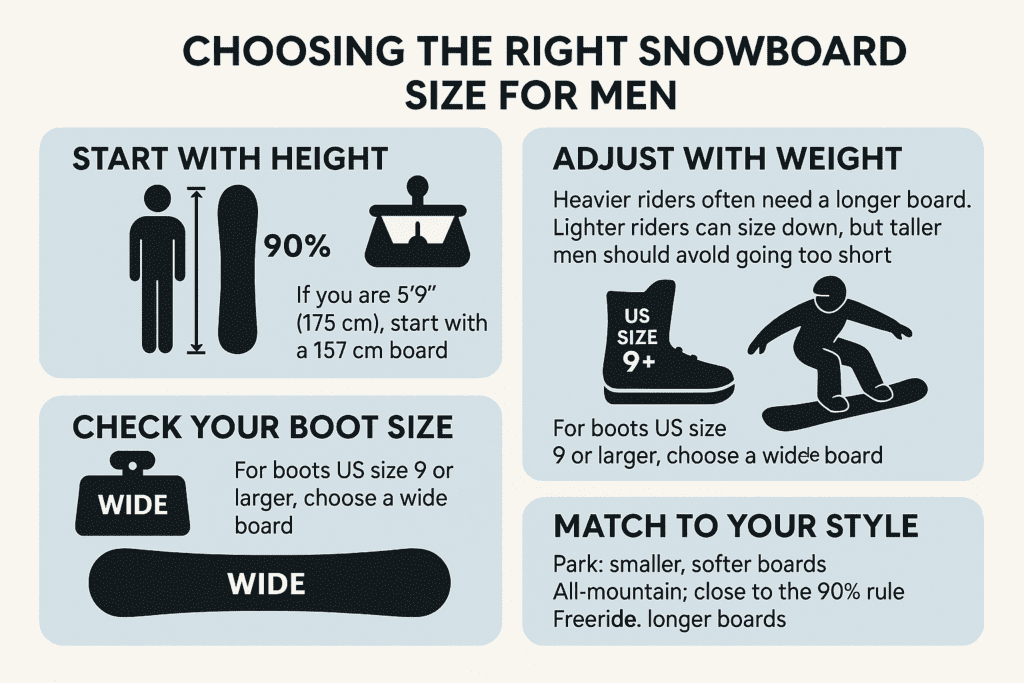
Heavier riders often need a slightly longer board to add stiffness and stability. Lighter riders can size down, but taller men should avoid going too short since height gives more leverage and demands control. Boot size matters too. If your boots are US size 9 or larger, you’ll want a wide board to avoid toe and heel drag.
Your riding style is the last adjustment. Park riders benefit from smaller, softer boards that feel playful and easy to maneuver. All-mountain riders should stick close to the 90 percent rule for balance across conditions. Freeriders often go a bit longer for edge hold, speed, and float in deeper snow.
Start with height, adjust with weight, check your boot size, and match the board to your style. This formula works for most men.
Is There a Difference in Snowboard Size for Men vs Women?
Yes, men’s and women’s snowboards differ in length, width, flex, and construction. Here’s a quick comparison:
| Feature | Men’s Boards | Women’s Boards |
|---|---|---|
| Length | Longer for taller, heavier riders | Shorter for lighter, smaller riders |
| Width | Wider for boot size 9+ | Narrower for smaller boots (~size 8) |
| Flex | Stiffer for aggressive riding | Softer for easy control |
| Materials | Stronger, heavier construction | Lighter materials for responsiveness |
Men are usually taller, heavier, and wear larger boots, so their boards are built longer, wider, and stiffer. Women’s boards are shorter, narrower, and softer, making them easier to control for lighter riders with smaller boot sizes. These design changes are not about skill level but about matching the board to body mechanics.
To merge this differences, unisex and volume shift boards give riders more options.
Unisex boards combine features that suit both men and women. Volume shift boards are shorter and wider, designed around shape and volume instead of gender.
Features of Men’s Snowboards
Men’s boards are designed with size, strength, and stability in mind. Here are the main features:
- Length: Most men’s boards measure 155–165 cm. Freeride boards can reach 170 cm or longer, giving more surface area for stability at high speed and float in deep snow. Shorter lengths, closer to 150–155 cm, are usually picked by men who ride park or focus on tricks.
- Width: Standard waist width is 245–255 mm, which fits boot sizes up to US 8.5. Wide boards range from 260–270 mm, built for riders with boots US 9–13. This extra width prevents toe and heel drag during sharp carves.
- Flex: Rated on a 1–10 scale, with 1 = softest and 10 = stiffest. All-mountain boards for men usually sit between 5–7, offering a mix of stability and versatility. Freeride boards lean stiffer, around 7–9, for strong edge hold and control at speed. Park boards stay softer, 3–5, so spins, butters, and presses feel easier.
- Construction: Men’s boards use denser wood cores, carbon stringers, and reinforced sidewalls. These materials add durability and strength to handle heavier weight and harder impacts.
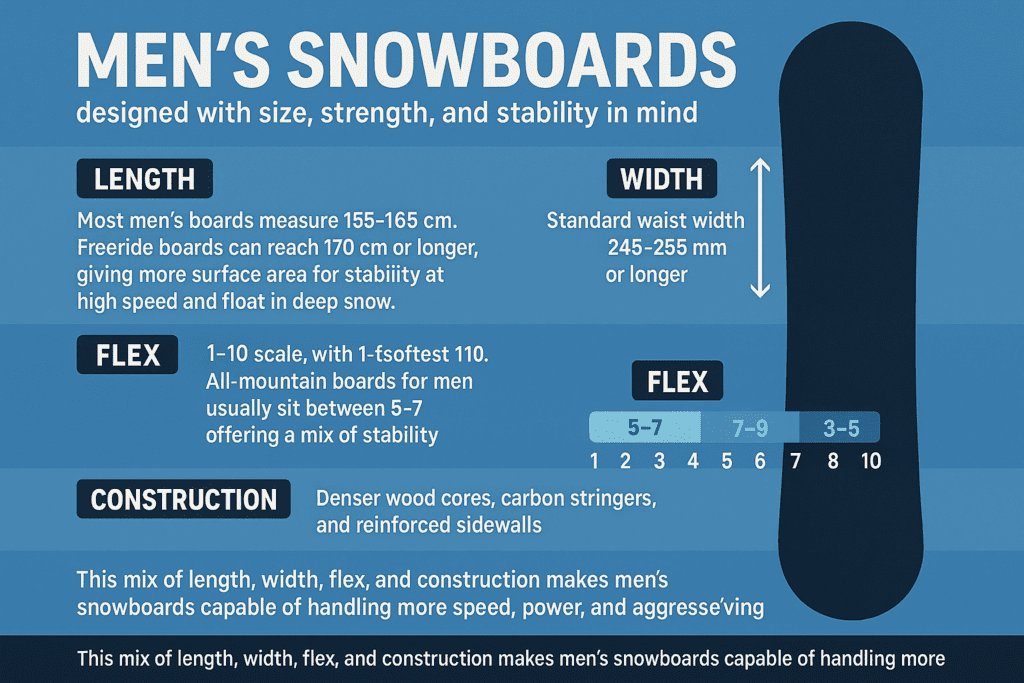
How to Choose the Perfect Snowboard Sizes for Men
Snowboard sizing is more than picking a number from a chart. A board’s sidecut and flex control how it turns, grips, and reacts under pressure. Larger boards are stiffer, giving more stability but demanding extra effort. Smaller boards feel playful but can lose edge hold if undersized.
The key is balance: a size that matches your height and weight while fitting the way you ride. Start with height, then refine through weight, flex, and style.
Height and Weight Considerations
Height gives you a clear starting point. A board should be about 90 percent of your height. For example, at 5’9” (175 cm), the baseline length is around 157 cm. Weight then fine-tunes that number.
Heavier riders often size up a few centimeters for added stiffness and stability. Lighter riders can size down slightly, but taller men should avoid going too short because extra height creates more leverage and demands control.
Here’s a simple guide:
| Rider Profile | Suggested Adjustment |
|---|---|
| Average height & weight | 90% of height (baseline) |
| Heavier than average | Size up 2–3 cm |
| Lighter than average | Size down 2–3 cm |
| Tall but light | Stay near baseline for control |
Matching Snowboard Size to Riding Style
Your riding style is just as important as your height and weight when choosing a board. Men often switch between park laps, all-mountain cruising, and freeride terrain, and each style favors a different size and flex.
| Riding Style | Board Length | Flex Range (1–10) | Key Benefits |
|---|---|---|---|
| Park | 150–155 cm (shorter) | 3–5 (softer) | Quick spins, easy presses, playful |
| All-Mountain | 155–162 cm (baseline) | 5–7 (medium) | Balance of speed, turns, and carving |
| Freeride | 160–170+ cm (longer) | 7–9 (stiffer) | Stability at speed, strong edge hold |
- Park riders go shorter and softer for agility. A 5’9” rider might size down to a 153 cm board.
- All-mountain riders stay near the 90% height rule. That same rider would pick around 157 cm.
- Freeriders size up for speed and powder. A 162–165 cm board delivers more control and float.
Sizing to match your style makes riding smoother and more enjoyable in the terrain you prefer most.
Flex Ratings and Model Examples
Flex rating decides how responsive and stable a board feels. The scale runs from 1 (softest) to 10 (stiffest). Softer boards bend easily and feel playful, while stiffer boards hold edges better and stay steady at speed.
| Flex Range | Best For | Typical Length Choice | Example Model | Key Traits |
|---|---|---|---|---|
| 3–5 (Soft) | Park riding | Near baseline height (e.g., 155–157 cm for 5’9”) | Burton Name Dropper | Easy spins, presses, and butters, less edge hold at speed |
| 5–7 (Medium) | All-Mountain use | 90% of rider height (e.g., 157 cm for 5’9”) | Various mid-flex models | Balanced mix of carving stability and playful feel |
| 7–9 (Stiff) | Freeride, carving | Can size down slightly (e.g., 152 cm instead of 158 cm) | Juggernaut | Strong edge hold, speed stability, ideal for aggressive riders |
Pro Tips:
Size down the board is stiff enough to handle your weight and speed. Stick to your baseline height if riding a softer board, or it may wash out. Compare flex ratings across brands since the feel can vary.
Advanced Sizing – Volume Shift Boards
Volume shift boards change the rules of sizing. Instead of being long and narrow, they are shorter and wider, keeping the same volume and surface area as a traditional board. This lets riders downsize without losing stability or float. For men, this design is useful if you want quicker turns and less board length underfoot but still need support for bigger boot sizes.
| Traditional Board Size | Volume Shift Equivalent | Boot Size Range | Example Models | Key Benefit |
|---|---|---|---|---|
| 160 cm | 152–154 cm | US 9–13 | Ride War Pig | Shorter length, stable for carving |
| 165 cm | 155–158 cm | US 9–13 | Lib Tech Orca | Extra float in powder, fast edge hold |
| 158 cm | 150–152 cm | US 9–12 | Never Summer Harpoon | Agile, playful feel with strong support |
Sizing Rule: Most brands recommend going 6–10 cm shorter than your normal size. For example, if you ride a 160 cm all-mountain board, you’d look for a 150–154 cm volume shift board.
This design gives men more flexibility, especially if they ride mixed terrain or want a board that feels lighter and more responsive.
FAQs
1. What snowboard length should a 5’9” man choose?
A board around 157 cm (90% of height) is a great starting point, with adjustments for weight and style.
2. Can heavier men ride shorter boards?
It’s possible with stiff boards, but generally heavier riders need longer boards for stability and edge hold.
3. Do men always need wide snowboards?
Only if boot size is US 9 or larger. Smaller boot sizes can use standard-width boards.
4. Are unisex boards good for men?
Yes, many unisex boards work well, especially for all-mountain riders, but check width and flex to match your body type.
5. How much can I downsize with volume shift boards?
Typically 6–10 cm shorter than your traditional size while maintaining stability.
6. Does riding style matter more than height?
Both matter, but riding style strongly influences the final choice (park vs freeride vs all-mountain).
Snowboard sizes for men matter more than most riders think. The right board length and width decide how stable, responsive, and enjoyable your time on the mountain will be. Pick a board that matches your body and style, and you’ll ride with more control, confidence, and comfort every day.
